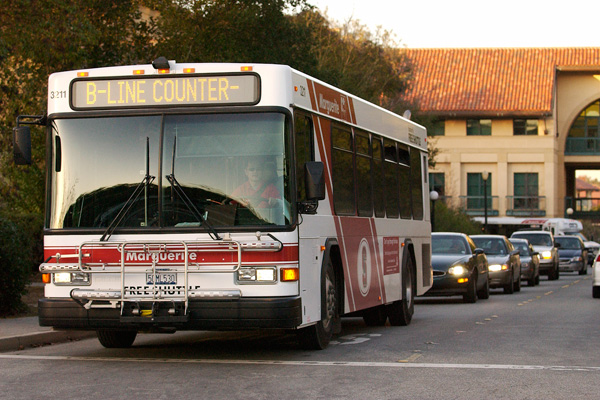Stanford proposes changing three Marguerite shuttle line routes
The university is seeking feedback on proposed changes to Marguerite routes that would help conserve fuel, lower emissions and reduce operating costs.
Stanford's Parking & Transportation Services department has proposed making significant changes to three Marguerite shuttle bus lines – Line A, Line B and the Midnight Express Line – that would go into effect in late 2010 if they are approved.
The Marguerite is Stanford’s free shuttle service, which travels around campus and connects to nearby public transit, including buses and Caltrain, and to shopping, dining and entertainment in surrounding communities.
In 2009-10, Marguerite shuttle buses ferried 1,460,000 riders to their destinations.
The department is seeking feedback on the proposed changes and has created an online question and comment form for input. Members of the university and hospital communities also may send comments to the department by emailing marguerite@stanford.edu.
The department, which says the proposed changes would conserve fuel, lower emissions and reduce operating costs, is seeking comments by Sept. 30.
The proposed changes were outlined in a Special eUpdate that was emailed to the Stanford community on Thursday.
There will be at least a two-week notice before any changes are made.
Proposed changes to Line A
The proposed changes would split the line into two routes: Line A and Line D. Each line would offer the same weekday service hours as the existing Line A.
- The proposed Line A would travel between the Palo Alto Transit Center and the Medical Center, Cantor Arts Center and the Oval.
- The proposed Line A would provide service frequency every 15 minutes between the Palo Alto Transit Center and two of the Marguerite's most popular stops: the Medical Center and the Main Quad/Oval.
- The proposed Line D would provide direct service between the Medical Center and Escondido Village via Serra Mall.
- For each of the proposed routes, Stanford would be able to eliminate one bus during non-peak periods of the day and run smaller buses during non-peak hours, conserving fuel, reducing emissions and reducing operating costs.
Proposed changes to Line B
The proposed changes would split the line into two routes: Line B and Line E. (Currently, Marguerite riders choose between Line B Clockwise and Line B Counter-Clockwise.) Each line would offer the same weekday service hours as the existing Line B.
- Line B would serve the west side of campus, traveling between the Palo Alto Transit Center, Stanford Hospital, and Tresidder Memorial Union.
- Line E would serve the east side of campus, traveling between the Palo Alto Transit Center, the Schwab Center, and Tresidder Memorial Union.
- The proposed changes would reduce the number of buses required from six to five during most of the day and would allow the use of smaller buses on the east side of campus (served by the proposed Line E). Operating smaller buses would increase fuel economy, reduce emissions and reduce operating costs.
- Renaming the routes would eliminate the "clockwise" and "counter-clockwise" designations that some riders find confusing.
Proposed changes to Midnight Express
The proposed changes would split the Midnight Express into two routes: Line N and Line Z. Each line would offer weekday and weekend service during the academic year.
- The proposed Line N would offer faster and more direct service between Palo Alto and the west side of campus, including Medical Center and student residence halls such as Lagunita Court and Sterling Quad.
- The proposed Line Z would offer faster and more direct service between Palo Alto and the east side of campus, including Escondido Village.
- The proposed routes would operate 16-passenger vans from Sunday through Thursday, rather than the larger buses currently used, offering better fuel economy, reducing emissions and reducing operating costs.


Share This Story